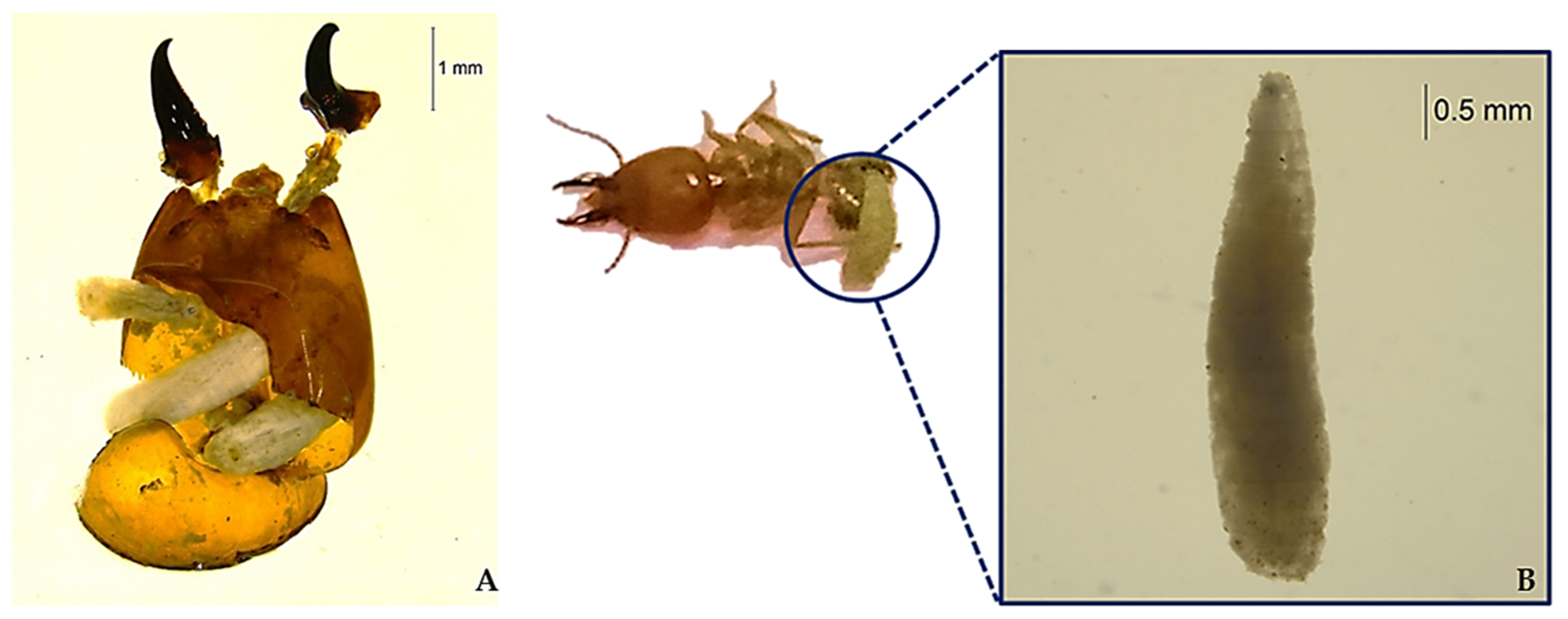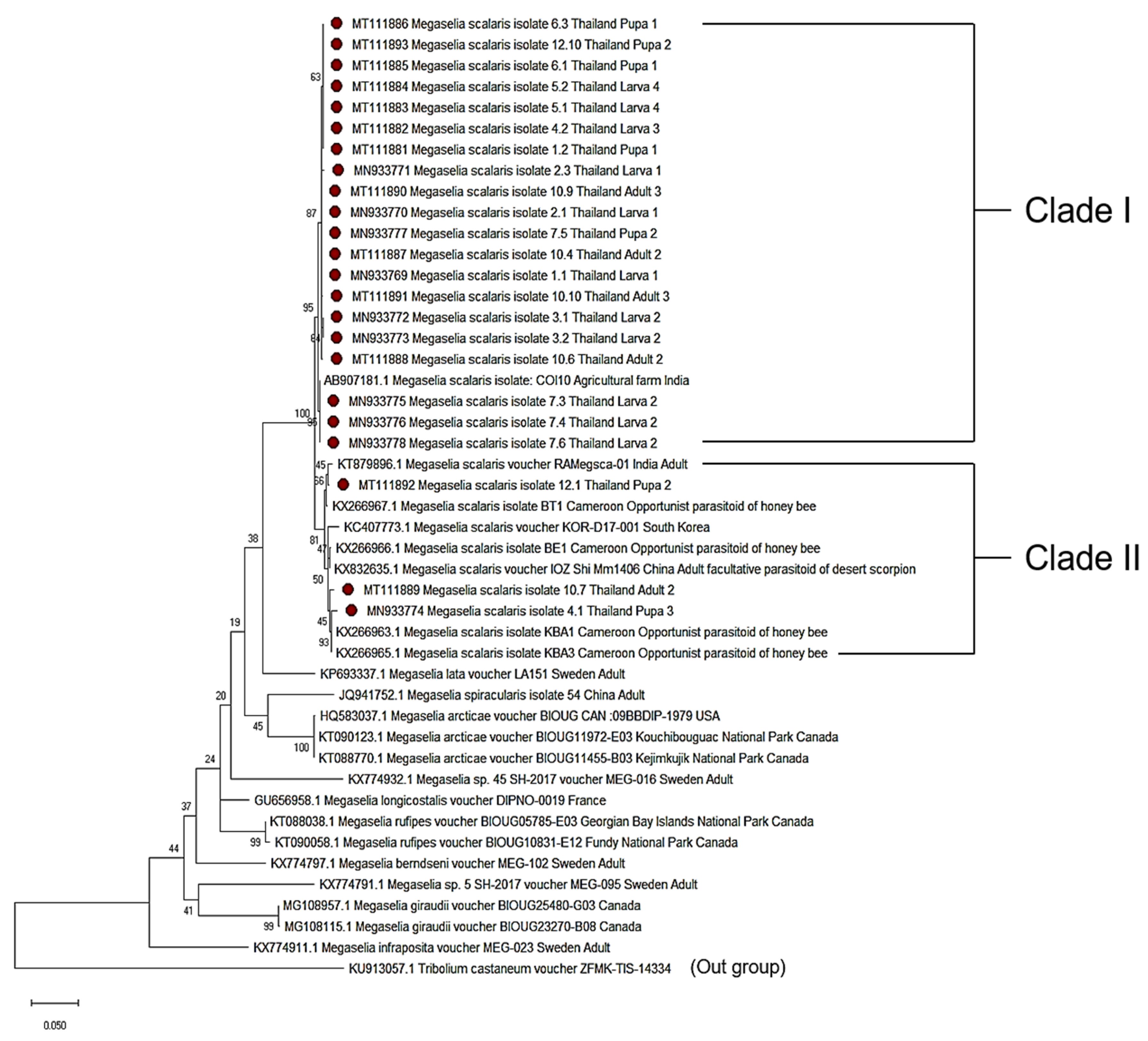Parasitism of Soldiers of the Termite, Macrotermes gilvus (Hagen), by the Scuttle Fly, Megaselia scalaris (Loew) (Diptera: Phoridae)
Abstract
1. Introduction
2. Materials and Methods
2.1. Termite Collection
2.2. Aggressive Behavior
2.3. Parasitic Diptera Collection and Morphological Identification
2.4. Molecular Identification of Parasitic Diptera
2.4.1. DNA Extraction
2.4.2. PCR Amplification
2.4.3. DNA Cloning and Sequencing
2.4.4. Phylogenetic Analysis
3. Results
3.1. Morphological Identification of Termites
3.2. Aggressive Behavior
3.3. Parasitic Diptera
3.4. Morphological Identification of Parasitic Diptera
3.5. Molecular Identification of Parasitic Diptera
3.6. Characteristics of Parasitized Termite Mounds
4. Discussion
5. Conclusions
Author Contributions
Funding
Acknowledgments
Conflicts of Interest
References
- Eggleton, P. Global patterns of termite diversity. In Termites: Evolution, Sociality, Symbioses, Ecology; Abe, T., Bignell, D.E., Higashi, M., Eds.; Springer: Dordrecht, The Netherlands, 2000; pp. 25–51. [Google Scholar]
- Lee, K.E.; Wood, T.G. Termites and Soils; Academic Press: London, UK, 1971. [Google Scholar]
- Sornnuwat, Y.; Vongkaluang, C.; Takematsu, Y. A systematic key to termites of Thailand. Kasetsart. J. (Nat. Sci.) 2004, 38, 349–368. [Google Scholar]
- Roonwal, M.L. Termites of the oriental region. In Biology of Termites; Krishna, K., Weesner, F.M., Eds.; Academic Press: New York, NY, USA, 1970; Volume 2, pp. 315–391. [Google Scholar]
- Neoh, K.B.; Lee, C.Y. Developmental stages and castes of two sympatric subterranean termites Macrotermes gilvus and Macrotermes carbonarius (Blattodea: Termitidae). Ann. Entomol. Soc. Am. 2009, 102, 1091–1098. [Google Scholar] [CrossRef]
- Lee, C.C.; Neoh, K.B.; Lee, C.Y. Caste composition and mound size of the subterranean termite Macrotermes gilvus (Isoptera: Termitidae: Macrotermitinae). Ann. Entomol. Soc. Am. 2012, 105, 427–433. [Google Scholar] [CrossRef]
- Neoh, K.B.; Lee, C.Y. Behavioral and morphological changes in soldiers of Macrotermes gilvus (Termitidae: Macrotermitinae) parasitized by Misotermes mindeni (Diptera: Phoridae). Environ. Entomol. 2010, 39, 835–840. [Google Scholar] [CrossRef] [PubMed][Green Version]
- Disney, R.H.L. Two remarkable new species of scuttle-fly (Diptera: Phoridae) that parasitize termites (Isoptera) in Sulawesi. Syst. Entomol. 1986, 11, 413–422. [Google Scholar] [CrossRef]
- Disney, R.H.L.; Kistnek, D.H. Revision of the termite-parasitizing genus Dicranopteron (Diptera: Phoridae). Zool. J. Linn. Soc. 1990, 98, 111–122. [Google Scholar] [CrossRef]
- Disney, R.H.L.; Neoh, K.B.; Lee, C.Y. A new species of scuttle fly (Diptera: Phoridae) parasitizing a termite (Isoptera: Termitidae) in Malaysia. Sociobiology 2009, 54, 89–94. [Google Scholar]
- Foo, F.K.; Othman, A.S.; Lee, C.Y. Morphology and development of a termite endoparasitoid Misotermes mindeni (Diptera: Phoridae). Ann. Entomol. Soc. Am. 2011, 104, 233–240. [Google Scholar] [CrossRef]
- Foo, F.K.; Othman, A.S.; Lee, C.Y. Parasitism by parasitoid Misotermes mindeni (Diptera: Phoridae) increases frequencies of trophallaxis and allogrooming in Macrotermes gilvus (Blattodea: Termitidae). In Proceedings of the 9th Pacific-Rim Termite Research Group Conference, Hanoi, Vietnam, 27–28 February 2012; pp. 199–203. [Google Scholar]
- Foo, F.K.; Othman, A.S.; Lee, C.Y. Longevity, trophallaxis, and allogrooming in Macrotermes gilvus soldiers infected by the parasitoid fly Misotermes mindeni. Entomol. Exp. Appl. 2015, 155, 154–161. [Google Scholar] [CrossRef]
- Foo, F.K.; Singham, G.V.; Othman, A.S.; Lee, C.Y. Prevalence of a koinobiont endoparasitoid Misotermes mindeni (Diptera: Phoridae) in colonies of the fungus-growing termite Macrotermes gilvus (Blattodea: Termitidae) in Malaysia. J. Econ. Entomol. 2011, 104, 1675–1679. [Google Scholar] [CrossRef]
- Neoh, K.B.; Lee, C.Y. Dipteran parasitism of subterranean termite soldiers, Macrotermes gilvus (Hagen) and Macrotermes carbonarius (Hagen) (Termitidae: Macrotermitinae). In Proceedings of the 6th Conference of the Pacific-Rim Termite Research Group, Kyoto, Japan, 2–3 March 2009; pp. 44–48. [Google Scholar]
- Neoh, K.B.; Lee, C.Y. The parasitoid, Verticia fasciventris causes morphological and behavioral changes in infected soldiers of the fungus-growing termite, Macrotermes carbonarius. J. Insect Sci. 2011, 11, 1–11. [Google Scholar] [CrossRef] [PubMed][Green Version]
- Sze, T.W.; Pape, T.; Toole, D.K. The first blow fly parasitoid takes a head start in its termite host (Diptera: Calliphoridae, Bengaliinae; Isoptera: Macrotermitidae). Syst. Biodivers. 2008, 6, 25–30. [Google Scholar] [CrossRef]
- To, T.M.D.; Lee, C.C.; Lee, C.Y. A survey of the prevalence of endoparasitism by Vertica fasciventris Malloch (Diptera: Calliphoridae) in colonies of Macrotermes carbonarius (Hagen) (Blattodea: Termitidae) in Penang Island, Malaysia. In Proceedings of the 11th Pacific Rim Termite Research Group Conference, Kunming, China, 18–19 April 2016; Forschler, B., Ed.; pp. 106–109. [Google Scholar]
- Liu, G.C.; Chen, G. New scuttle flies (Diptera: Phoridae) reared from dead termite, Odontotermes formosanus (Shiraki, 1909) (Isoptera: Termitidae) in China. Zootaxa 2019, 4551, 237–243. [Google Scholar] [CrossRef] [PubMed]
- Ahmad, M. Termites (Isoptera) of Thailand. Bull. Am. Mus. Nat. Hist. 1965, 131, 1–113. [Google Scholar]
- Intanai, I. Taxonomic Studies and Some of Their Ecological Factors of Termites in Chanthaburi and Trat Provinces. Master’s Thesis, Chulalongkorn University, Bangkok, Thailand, 1987. [Google Scholar]
- Thyssen, P.J. Keys for identification of immature insects. In Current Concepts in Forensic Entomology; Amendt, J., Goff, M.L., Campobasso, C.P., Grassberger, M., Eds.; Springer: Dordrecht, The Netherlands, 2010; pp. 25–42. [Google Scholar]
- Bostock, E. Megaselia scalaris (Diptera: Phoridae), a Fly of Forensic Interest: Advances in Chronobiology and Biology. Ph.D. Thesis, University of Huddersfield, West Yorkshire, UK, 2015. [Google Scholar]
- Solgi, R.; Djadid, N.D.; Eslamifar, A.; Raz, A.; Zakeri, S. Morphological and molecular characteristic of Megaselia scalaris (Diptera: Phoridae) larvae as the cause of urinary myiasis. J. Med. Entomol. 2017, 54, 781–784. [Google Scholar] [CrossRef] [PubMed]
- Disney, R.H.L. Scuttle Flies: Diptera, Phoridae (Except Megaselia): Handbooks for the Identification of British Insects Vol. 10, Part 6; Royal Entomological Society of London: London, UK, 1983. [Google Scholar]
- Disney, R.H.L. Scuttle Flies: Diptera, Phoridae (Genus Megaselia): Handbooks for the Identification of British Insects Vol. 10, Part 8; Royal Entomological Society of London: London, UK, 1989. [Google Scholar]
- Alam, M.S.; Ahmed, K.A.; Begum, R.A.; Shahjahan, R.M. Identification of Megaselia species based on mitochondrial 16s rRNA and CO1 gene sequences. Dhaka Univ. J. Biol. Sci. 2016, 25, 149–159. [Google Scholar] [CrossRef]
- Zhang, X.S.; Liu, G.C.; Zhang, D.X.; Shi, C.M. Novel trophic interaction: The scuttle fly Megaselia scalaris (Diptera: Phoridae) is a facultative parasitoid of the desert scorpion Mesobuthus eupeus mongolicus (Scorpiones: Buthidae). J. Nat. Hist. 2017, 51, 1–15. [Google Scholar] [CrossRef]
- Hall, T.A. BioEdit: A user-friendly biological sequence alignment editor and analysis program for 349 Windows 95/98/NT. Nucleic. Acids. Symp. Ser. 1999, 41, 95–98. [Google Scholar]
- Kumar, S.; Stecher, G.; Li, M.; Knyaz, C.; Tamura, K. MEGA X: Molecular evolutionary genetics analysis across computing platforms. Mol. Biol. Evol. 2018, 35, 1547–1549. [Google Scholar] [CrossRef]
- Costa, J.; Almeida, C.E.; Esperanca, G.M.; Morales, N.; Dos, S.; Mallet, J.R.; Goncalves, T.C.; Do Prado, A.P. First record of Megaselia scalaris (Loew) (Diptera: Phoridae) infesting laboratory colonies of Triatoma brasiliensis Neiva (Hemiptera: Reduviidae). Neotrop. Entomol. 2007, 36, 987–989. [Google Scholar] [CrossRef][Green Version]
- Andreotti, R.; Koller, W.W.; Tadei, W.J.; Do Prado, Â.P.; Barros, J.C.; Dos Santos, F.; Gomes, A. Ocurrence of the Megaselia scalaris as a parasitoid of Boophilus microplus in Campo Grande, MS, Brazil. Rev. Bras. Parasitol. Vet. 2003, 12, 46–47. [Google Scholar]
- Cham, D.T.; Fombong, A.T.; Ndegwa, P.N.; Irungu, L.W.; Nguku, E.; Raina, S.K. Megaselia scalaris (Diptera: Phoridae), an opportunist parasitoid of honey bees in Cameroon. Afr. Entomol. 2018, 26, 254–258. [Google Scholar] [CrossRef]
- Debnath, P.; Roy, D. First record of Megaselia scalaris (Loew) as a potential facultative parasitoid of Apis mellifera in India. Asian J. Biol. 2019, 7, 1–9. [Google Scholar] [CrossRef]
- Somavilla, A.; Schoeninger, K.; Carvalho, A.F.; Menezes, R.S.T.; Del Lama, M.A.; Costa, M.A.; Oliveira, M.L. Record of parasitoids in nests of social wasps (Hymenoptera: Vespidae: Polistinae). Sociobiology 2015, 62, 92–98. [Google Scholar] [CrossRef][Green Version]
- Koch, N.M.; Fontanarrosa, P.; Padró, J.; Soto, I.M. First record of Megaselia scalaris (Loew) (Diptera: Phoridae) infesting laboratory stocks of mantids (Parastagmatoptera tessellata, Saussure). Arthropods 2013, 2, 1–6. [Google Scholar]
- Batista-Da-Silva, J.A. Phoretic association and facultative parasitoidism between Megaselia scalaris and blowflies, under natural conditions. OnLine J. Biol. Sci. 2012, 12, 34–37. [Google Scholar]
- Marchiori, C.H. First occurrence of Megaselia scalaris (Loew) (Diptera: Phoridae) in pupae of Palaeosepsis sp. (Diptera: Sepsidae) in Brazil. Int. J. Res. Pharm. Biosci. 2018, 5, 7–9. [Google Scholar] [CrossRef]
- Ruíz-Nájera, R.E.; Molina-Ochoa, J.; Carpenter, J.E.; Espinosa-Moreno, J.A.; Ruíz-Nájera, J.A.; Lezama-Gutiérrez, R.; Foster, J.E. Survey for Hymenopteran and Dipteran parasitoids of the fall armyworm (Lepidoptera: Noctuidae) in Chiapas, Mexico. J. Agric. Urban Entomol. 2007, 24, 35–42. [Google Scholar] [CrossRef]
- Machkour-M’Rabet, S.; Dor, A.; Hénaut, Y. Megaselia scalaris (Diptera: Phoridae): An opportunistic endoparasitoid of the endangered Mexican redrump tarantula, Brachypelma vagans (Araneae: Theraphosidae). J. Arachnol. 2015, 43, 115–119. [Google Scholar] [CrossRef]
- Diyes, G.C.P.; Karunaratne, W.A.I.P.; Tomberlin, J.K.; Rajakaruna, R.S. First record of Megaselia scalaris (Loew) (Diptera: Phoridae) infesting a spinose ear tick, Otobius megnini, colony in Sri Lanka. Trop. Biomed. 2015, 32, 791–795. [Google Scholar]
- Miranda-Miranda, E.; Cossío-Bayúgar, R.; Martinez-Ibañez, F.; Bautista-Garfias, C.R. Megaselia scalaris reared on Rhipicephalus (Boophilus) microplus laboratory cultures. Med. Vet. Entomol. 2010, 25, 344–347. [Google Scholar] [CrossRef] [PubMed]
- Morrison, L.W. Biological control of Solenopsis fire ants by Pseudacteon parasitoids: Theory and practice. Psyche 2012, 2012, 424817. [Google Scholar]
- Porter, S.D.; Gilbert, L.E. Assessing host specificity and field release potential of fire ant decapitating flies (Phoridae: Pseudacteon). In Assessing Host Ranges for Parasitoids and Predators Used for Classical Biological Control: A Guide to Best Practice; Van Driesche, R.G., Murray, T., Reardon, R., Eds.; USDA Forest Service: Morgantown, WV, USA, 2004; pp. 152–176. [Google Scholar]
- Wuellner, C.T.; Dall’Aglio-Holvorcem, C.G.; Benson, W.W.; Gilbert, L.E. Phorid fly (Diptera: Phoridae) oviposition behavior and fire ant (Hymenoptera: Formicidae) reaction to attack differ according to Phorid species. Ann. Entomol. Soc. Am. 2002, 95, 257–266. [Google Scholar] [CrossRef][Green Version]
- Bautista-Garfias, C.R.; Martínez-Ibañez, F. Experiences on the control of cattle tick Rhipicephalus (Boophilus) microplus in Mexico. In Ticks: Disease, Management and Control; Woldemeskel, M., Ed.; Nova Science Publishers, Inc.: New York, NY, USA, 2012; pp. 205–216. [Google Scholar]


| Mound Number | Caste of Soldier Termites | No. of Individual Soldiers | No. of Non-Aggressive Soldiers | No. of Parasitized Soldiers | Percentage of Soldiers | |
|---|---|---|---|---|---|---|
| Non-Aggressive | Parasitized | |||||
| 1 | Major | 153 | 73 | 67 | 47.71 | 43.79 |
| Minor | 312 | 4 | 2 | 1.28 | 0.64 | |
| 2 | Major | 331 | 317 | 157 | 95.77 | 47.43 |
| Minor | 515 | 379 | 0 | 73.59 | 0.00 | |
| 3 | Major | 350 | 11 | 3 | 3.14 | 0.86 |
| Minor | 489 | 3 | 1 | 0.62 | 0.21 | |
| 4 | Major | 172 | 45 | 6 | 26.16 | 3.49 |
| Minor | 356 | 0 | 0 | 0.00 | 0.00 | |
© 2020 by the authors. Licensee MDPI, Basel, Switzerland. This article is an open access article distributed under the terms and conditions of the Creative Commons Attribution (CC BY) license (http://creativecommons.org/licenses/by/4.0/).
Share and Cite
Noknoy, R.; Sunantaraporn, S.; Phumee, A.; Siriyasatien, P.; Sanguansub, S. Parasitism of Soldiers of the Termite, Macrotermes gilvus (Hagen), by the Scuttle Fly, Megaselia scalaris (Loew) (Diptera: Phoridae). Insects 2020, 11, 318. https://doi.org/10.3390/insects11050318
Noknoy R, Sunantaraporn S, Phumee A, Siriyasatien P, Sanguansub S. Parasitism of Soldiers of the Termite, Macrotermes gilvus (Hagen), by the Scuttle Fly, Megaselia scalaris (Loew) (Diptera: Phoridae). Insects. 2020; 11(5):318. https://doi.org/10.3390/insects11050318
Chicago/Turabian StyleNoknoy, Royto, Sakone Sunantaraporn, Atchara Phumee, Padet Siriyasatien, and Sunisa Sanguansub. 2020. "Parasitism of Soldiers of the Termite, Macrotermes gilvus (Hagen), by the Scuttle Fly, Megaselia scalaris (Loew) (Diptera: Phoridae)" Insects 11, no. 5: 318. https://doi.org/10.3390/insects11050318
APA StyleNoknoy, R., Sunantaraporn, S., Phumee, A., Siriyasatien, P., & Sanguansub, S. (2020). Parasitism of Soldiers of the Termite, Macrotermes gilvus (Hagen), by the Scuttle Fly, Megaselia scalaris (Loew) (Diptera: Phoridae). Insects, 11(5), 318. https://doi.org/10.3390/insects11050318








